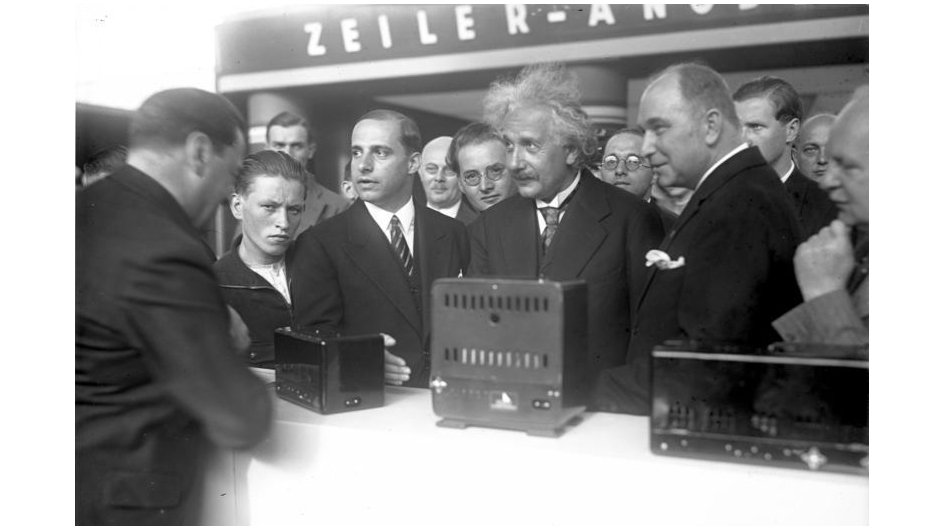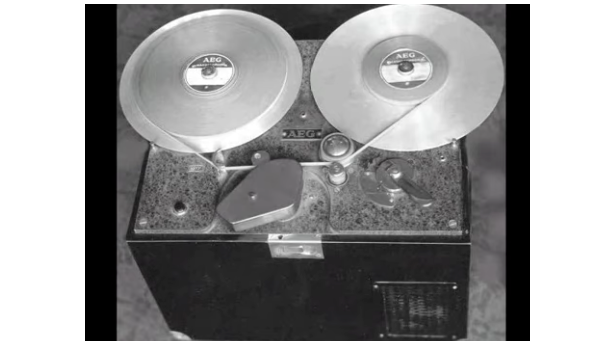
The Internationale Funkausstellung Berlin – or the International Radio Exhibition Berlin, or IFA to us – has been around for a while. Originating as a radio show back in 1924 (called the Große Deutsche Funkausstellung), Europe's biggest and oldest consumer electronics exhibition is a playground for brands from all over the world to showcase their latest products and innovations. It has also been through a fair few name changes, one World War and a global pandemic – and it continues to thrive today.
- IFA 2024: latest news from this year's tech show
IFA has seen the debut of various new technologies and audio/visual products, such as tape recorders and cassette players, TV technologies – from early CRT and inaugural colour TV to cutting-edge 3D TV and OLED of the 21st century – along with a few format wars, crazy conceptual products and era-defining hi-fi and home cinema products that we know and love.
Below is a whistle-stop tour of some of the key moments in IFA's 100-year history. If you were around for any of them in person, or have any other product, tech or personal highlights from the IFA show, feel free to share in the comments.
Albert Einstein opens the show (1930)

Celebrity guests don't get better than this. Forget Michael Bay and Paris Hilton; esteemed theoretical physicist and all-round genius Albert Einstein opened the seventh IFA show in Berlin in 1930. He paid tribute to his fellow scientists, engineers and inventors (Oersted, Reis, Maxwell, Hertz) and spoke of the wonder and importance of radio communication; the first live radio broadcast had taken place at the 1926 exhibition.
It was called the Great German Radio and Phonograph Show back then and the key highlight was the first showing of a prototype 'television receiver' to the public. This was one year before television broadcasting officially started in Germany.
You can see a video of Einstein's speech here.
World's first CRT TV demo (1931)
Speaking of which, another German physicist and inventor, Manfred von Ardenne, was responsible for giving the first public demonstration of a cathode ray tube (CRT) television system at the 1931 show.
This TV was able to both transmit and receive images, and a few years later in 1939 the first prototype of a colour TV was unveiled. The exhibition was rebranded that year as Große Deutsche Funk- und Fernseh-Ausstellung (Great German Radio and Television Exhibition) to recognise the advent of TV technology.
It wouldn't be until 1967 that colour TV broadcast was fully implemented in West Germany...
Magnetophon K1 tape recorder (1935)

The German electronics brand AEG (founded in 1883) showcased the first practical audio tape recorder at the 1935 Berlin show. Called the Magnetophon K1, this magnificent device was a reel-to-reel tape recorder, based on the magnetic tape (or 'sound paper machine') invented and patented by Fritz Pfleumer in 1928. This tech was licensed to AEG, who then developed a more stable cellulose acetate-based tape, and thus the K1 was born. It was more cost-effective and had superior sound quality to rival steel-tape designs.
One of the first live concerts ever to be recorded was on a Magnetophon tape recorder (on the next-gen K2 model): Mozart's 39th Symphony was played by the London Philharmonic Orchestra in 1936, conducted by Sir Thomas Beecham. While early Magnetophon-recorded tapes weren't of the greatest quality, later generations (and even better tape material) resulted in greater recording quality.
You can hear a recording made in 1935 of the original K1 here.
Philips EL3300 – world's first compact cassette recorder (1963)

In August 1963, Philips revealed the first compact audio cassette recorder to the world, and music storage and playback would for ever be changed (until CDs, iPods, computers, and downloadable digital files appeared...)
The Philips EL3300 was developed by cassette inventor Lou Ottens. It was battery-operated, had inputs for the microphone, a red light to indicate recording and it was brown. Very brown. It was also pretty pocketable, measuring just 11.3 x 5.6 x 19.6cm (or 4.4 x 2.2 x 7.7 inch).
60 years later, who would have thought that cassette tapes would be having a mini resurgence?
Colour TV launches in West Berlin (1967)

We can only imagine the frisson of excitement and wonder, as on the morning of 25th August 1967, at the IFA show floor (then called the International Radio and TV Fair), foreign minister and vice-chancellor Willy Brandt symbolically pressed a red button to mark the new era of colour TV in West Germany.
It didn't just switch on colour TV; West Germany became the first country in Europe to introduce colour on two TV channels at the same time (ARD and ZDF). A momentous occasion, indeed.
Colour TV had arrived to UK viewers only a month earlier. On 1st July 1967, BBC2 presented the first TV show in colour – the Wimbledon Tennis Championships presented by David Vine – to the public. The broadcast used the PAL (Phase Alternating Line) system, which originated from German television pioneer and engineer Walter Bruch. The PAL system was used for the colour TV launch at IFA 1967.
1971: IFA goes international, Funk-Otto logo

It was in 1971 that IFA became the internationally renowned technology show we know today. It was rebranded as the Internationale Funkausstellung (or IFA for short) and the famous "Funk-Otto" logo, created by German graphic artist Helmut Lortz, became the emblem of the show.
IFA has become one of the fixtures of the technology calendar, with the latest innovations and new products being presented to a global audience – CDs, MiniDiscs, digital/HD TVs, DAB radio, MP3 players, games consoles and – since the late 2000s – home appliances all have made their debut at the Berlin show since.
HD TV and Casio pocket TVs (1985)

Philips's prototype 3D TV made its debut in 1983, but 1985 was more momentous. Not only did high-definition HD TV get shown to the public for the first time – along with the first satellite receivers for TV – but Casio (yes, the makers of calculators) introduced pocket TVs.
These adorable pocket-sized TVs were about the size of a calculator or Sony Walkman and had a 2.5-inch screen.
Sony introduces MiniDisc prototype (1991)

Sony presented the first prototype of its MiniDisc at IFA 1991, with the format widely available from 1992 in Japan and Europe. Pictured above is the first MiniDisc player, the Sony MZ1.
As a replacement for the compact cassette, MiniDisc allowed you to store more than an hour of digital music (and it was rewritable) on a tiny 2.5-inch disc. The slow uptake of MiniDisc in the US, combined with fierce competition from cheaper CD-R discs and the introduction of MP3 players, meant that MiniDisc and MD players didn't quite catch on and became obsolete as digital music technology advanced.
HD DVD vs Blu-ray (2006-2008)

The hi-fi and home cinema landscape is rife with format wars (RIP Betamax), but one of the most brutal, short-lived format wars was for the successor to DVD.
The Toshiba-backed HD DVD (High Definition Digital Versatile Disc) launched in 2006 and ended in 2008, with the rival Blu-ray format winning the battle. Those attending IFA 2007 would have been privy to pretty heated to-and-fro during the press conferences from the Blu-ray Disc Association (whose approach we called "bullish" and "aggressive" and the HD DVD group (who valiantly fought back with a cheaper alternative).
An HD DVD disc could store 15GB, three times that of DVD, and its audio support – 24-bit/192kHz audio (for two channels) or 24-bit/96kHz (for up to eight) – was impressive too. However, Blu-ray could store 30GB and 2007's PlayStation 3 being equipped with a Blu-ray drive cemented the future.
By IFA 2008, HD DVD had dissolved and Blu-ray (backed by Sony, 20th Century Fox and Warner Bros.) emerged victorious.
11 foot tall, £300k iPod dock (2011)

Proving it's not just Las Vegas's CES trade show that attracts the weird, the wonderful and the extravagantly expensive, 2011's IFA saw "the most extraordinary creation in the history of recorded sound: half machine, half work of art".
That would be the AeroDreamOne, a prototype speaker system from French musician Jean Michel Jarre, which boasted 10,000 watts of power, weighed 394kg and stood 11-foot tall. Of course, you need a ladder to reach the top to dock in your iPod or iPad.
Priced at around £300,000 (or $565,000), this is an iPod dock that only giants could dream of owning.
Technics makes a hi-fi comeback (2014)

After six years away (a lifetime in the tech landscape) parent company Panasonic announced that Technics would be back in business at IFA 2014. The brand returned with a host of new hi-fi products, including the high-end Reference Class R1 series that consisted of an amplifier, network streamer and preamplifier, a pair of speakers, and the more real-world-priced Premium Class C700 range that also included a CD player.
We reviewed three of the C700 products to rather disappointing results (two and three stars abound), but while it wasn't the most successful comeback, Technics hi-fi products since have only grown stronger and stronger.
Technics has launched two new products at this year's IFA 2024: a new SL-1300G direct drive turntable and the SC-CX700 wireless speaker system.
LG unveils world's largest 77-inch curved 4K OLED screen (2013)

TV tech has not stopped advancing. In the 2010s and onwards, we have seen 4K OLED TVs, transparent TVs, rollable TVs, curved screens, ultra-slim and gigantic 8K screens with even newer technology to dazzle our eyes.
January's CES show tends to get world-first dibs on the craziest, most eye-catching displays, but LG reserved a "world's first" for showgoers at IFA 2013. There, it unveiled the (then) largest 77-inch curved 4K OLED screen. Wowzers.
We've also seen, courtesy of LG, a spectacular OLED tunnel which remains one of the best uses of the curved OLED screen tech beyond watching David Attenborough's Blue Planet in 4K.
MORE:
Technics surprises us with a KEF-rivalling wireless speaker system at IFA 2024
Hisense confirms its super-sized 110-inch Mini LED TV with 40,000 dimming zones is coming to the UK







